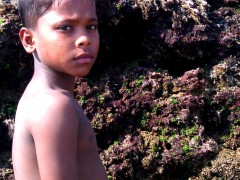The “Green Life Value” as a new way to put a price on nature


A fisherboy on the shores of the Karachi beach next to one of the Environment Protection Agency’s ecological significant mangrove forest. Photo by S. Aown Shahzad / Pakistan
In our modern world the financialization of nature is already done whether we like it or not. For instance the price of a tree is determined by its timber. Only a quarter of the actual use of a tree is through its timber though. Therefore in establishing the economics of nature we need to take the UN-REDD+ programme to new grounds. This we do by adding a cost for the tree’s use as a carbon store, its ability to produce fruit and oxygen, a cost for other animals’ dependency on it and lastly the cost for the indigenous people who directly or indirectly rely on the tree, for example, for protection against climate impacts, like floods.
Nature provides us many benefits. Confining it to one attribute and using that as the basis of our valuation is unfair because it leaves us undervaluing it. Climate Change mitigation as per a carbon store is just one such factor. Nature in its power also helps us in adapting to Climate Change which is equally as important and sometimes even more so for the developing “climate risk” part of the world. But again that is just one factor more.
For this reason I propose we take into account the combining factors of nature which in all function to run that one process i.e. the process of life. That’s when I find assessing nature’s monetary value is useful and productive i.e. when the economy of nature is valued by its life sustaining and protecting index. Put simply, we measure the environment’s value under the expression of “Green Life” which can be used as the basic unit of our value system. The green life value is calculated in terms of an area’s total plant cover, biodiversity, natural resources (like food & water), its ecological significance and its importance in mitigation or adaptation to climate change and lastly by the area’s mean number of beneficiaries.
Let me elaborate on this:
- Land providing natural sustenance and protection to its inhabitants via food source and Climate Change mitigation and/or adaptation is our high Green Life source, for example the rainforest in Brazil or the mangroves of Pakistan.
- Land providing sustenance but not physical protection or vice versa is our medium Green Life source, like the numerous fish ponds of The Philippines.
- Land devoid of providing sustenance is our negligible Green Life source, for example a barren land due to industrial waste.
This leaves us with categorical ranks of high, medium, low and negligible source of Green Life which is then used as an indicator to establish the economic value of the place. To do this we calculate all the factors of benefit provided by the place and then add them together to rank the importance of the place for the survival & sustenance of life and lastly using that to confer its monetary value.
So in the new valuation system I say, we firstly introduce the method of nature – benefit analysis and thus start valuing a tree planted in the ground more than its timber in a shop. Moreover, the economic aspect those cutting/buying the trees should be made to pay for the tree’s timber, but also pay annually for its carbon storing/converting capacity which will now be diminished forever. Thus they’re essentially paying for the wood and a tax for the other factors that will no longer be functional due to the removal of that tree including the amount it would take to remove CO2 from the atmosphere that the tree was originally storing and/or converting. Inclusion of these several factors helps us determine its monetary value more accurately and enables us to compensate appropriately.
So in Financialization of Nature let’s do it the right way. Let’s value it on the basis of its significance entirely. Only by doing so can we begin to grasp nature’s costly monetary value and only can we then encourage better environmental policy and practices internationally. Moreover the high price will definitely help us in promoting a sustainable approach worldwide because of the now higher economical value and will also enable us to promote environmentalism and tackle numerous environment crisis as opposed to just Carbon storing. Simultaneously environmental legislation will also strengthen because this new process presents all countries the chance to be re-ranked on the basis of their nature reserves which ensure their sustenance and survival. It presents poor countries with the opportunity to be labeled rich and gain influence because of the fact that they can sustain themselves and other nations. While it leaves richer countries with limited green life but high economic power to start giving more preference to their natural assets.
It is to be noted that this is limited to unthreatened areas only. In case of vulnerable areas monetary compensation along with physical efforts should be required. This helps us keep a balance with nature and prevents exploitation of nature as costly conservation activities are the price to pay. In other words the price for destroying green life is restoration of the green life, which moreover helps us hinder exploitation as there is no “buying out” option for a priority place.
The solution presented above was selected as the winner of the Open Solution call for new ideas by the Global Economic Symposium and was to be presented at the GES 2013 in Kiel, Germany.
Tags: CLIMATE CHANGE, earth, economics, ENVIRONMENT, Financial, GES, Global Economic Symposium, Green Life Value, Industrialization, Mangroves, nature, Open Solution, Price, Rainforest, UN, UNEP, UNFCCC
